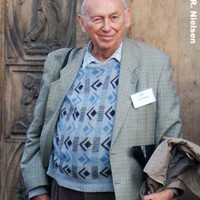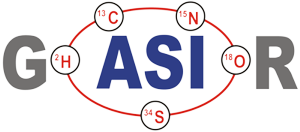
Dr. Nielsen died only a few months after the publication of a special issue honoring his 90th birthday (Böttcher, M.E. & Hoefs, J., 2012. Sulphur tales: A tribute on the occasion of the 90th birthday of Heimo Nielsen, Isotopes in Environmental and Health Studies, 48), containing an editorial that provides the base for the following text.
Heimo Nielsen was born on April, 27th, 1920 in Glückstadt and grew up in Hamburg, Germany. After school he started first studying physics. After the second world war, he switched to mineralogy at the University of Hamburg, and received his Dr. rer nat. degree in 1953 with a work on columbite and tantalite. In the following years he worked for the German Geological Survey, BGR, and NLfB in Hannover.
Heimo Nielsen started working on sulfur isotopes in the early 1960s when he directed the newly founded "Central Laboratory for the Geochemistry of Stable Isotopes (German: Zentrallabor für Geochemie stabiler Isotope)" in Göttingen.
At that time, sulfur isotopes in earth sciences were still in its stages of infancy. The precise measurement of stable isotope ratios was restricted to a small number of laboratories around the world, which generally were specialized in the analysis of one particular element.
Heimo Nielsen was the first to measure sulfur isotopes in West-Germany. During the early years his major efforts focused on the investigation of ore deposits in Germany (for a complete bibliography, see Böttcher & Hoefs, 2012). L
ater on, his interests shifted to biogeochemical processes, concentrating on the changes in sulfate and sulfide reservoirs in the global sulfur cycle over geologic time, as reflected for instance by marine evaporite deposits. As an example, his classic publication with Martin Hartmann, his co-worker from Kiel University, was reprinted in 2012 for the first time in a recent English translation (Hartmann, M. & Nielsen, H., 2012, δ34S values in recent sea sediments and their significance using several sediment profiles from the western Baltic Sea. Isotopes in Environmental and Health Studies, 48, 7-32.).
Although 1969 originally published in German, a recent SCHOLAR search gives 140 citations of this seminal publication in the international scientific literature.
Until his retirement in 1986 and even later, Heimo Nielsen served at the Georg-August University of Göttingen, teaching stable isotope courses, and training students and colleagues.
In 2010, Heimo Nielsen received the honorary membership of the GASIR. Heimo Nielsen is survived by his son Rainer, who was of fundamental support during the last years.
Michael E. Böttcher(1) and Jochen Hoefs(2)
(1) Geochemistry & Stable Isotope Geochemistry Group, Marine Geology Section, Leibniz Institute for Baltic Sea Research (IOW), Warnemünde, Germany
(2) Geochemical Institute, Georg-August University of Göttingen, Germany
Heimo Nielsen was born on April, 27th, 1920 in Glückstadt and grew up in Hamburg, Germany. After school he started first studying physics. After the second world war, he switched to mineralogy at the University of Hamburg, and received his Dr. rer nat. degree in 1953 with a work on columbite and tantalite. In the following years he worked for the German Geological Survey, BGR, and NLfB in Hannover.
Heimo Nielsen started working on sulfur isotopes in the early 1960s when he directed the newly founded "Central Laboratory for the Geochemistry of Stable Isotopes (German: Zentrallabor für Geochemie stabiler Isotope)" in Göttingen.
At that time, sulfur isotopes in earth sciences were still in its stages of infancy. The precise measurement of stable isotope ratios was restricted to a small number of laboratories around the world, which generally were specialized in the analysis of one particular element.
Heimo Nielsen was the first to measure sulfur isotopes in West-Germany. During the early years his major efforts focused on the investigation of ore deposits in Germany (for a complete bibliography, see Böttcher & Hoefs, 2012). L
ater on, his interests shifted to biogeochemical processes, concentrating on the changes in sulfate and sulfide reservoirs in the global sulfur cycle over geologic time, as reflected for instance by marine evaporite deposits. As an example, his classic publication with Martin Hartmann, his co-worker from Kiel University, was reprinted in 2012 for the first time in a recent English translation (Hartmann, M. & Nielsen, H., 2012, δ34S values in recent sea sediments and their significance using several sediment profiles from the western Baltic Sea. Isotopes in Environmental and Health Studies, 48, 7-32.).
Although 1969 originally published in German, a recent SCHOLAR search gives 140 citations of this seminal publication in the international scientific literature.
Until his retirement in 1986 and even later, Heimo Nielsen served at the Georg-August University of Göttingen, teaching stable isotope courses, and training students and colleagues.
In 2010, Heimo Nielsen received the honorary membership of the GASIR. Heimo Nielsen is survived by his son Rainer, who was of fundamental support during the last years.
Michael E. Böttcher(1) and Jochen Hoefs(2)
(1) Geochemistry & Stable Isotope Geochemistry Group, Marine Geology Section, Leibniz Institute for Baltic Sea Research (IOW), Warnemünde, Germany
(2) Geochemical Institute, Georg-August University of Göttingen, Germany
With sadness we have to inform the stable isotope community that
Dr. Heimo Nielsen,
longterm member and continuous supporter of the German Association of Stable Isotope Research (GASIR) , passed away on October 12th, 2012 in Göttingen, Germany. He was well known for his pioneering work on the stable isotope geochemistry of the natural sulfur cycle.
Dr. Heimo Nielsen,
longterm member and continuous supporter of the German Association of Stable Isotope Research (GASIR) , passed away on October 12th, 2012 in Göttingen, Germany. He was well known for his pioneering work on the stable isotope geochemistry of the natural sulfur cycle.

Nachruf auf unser Ehrenmitglied Dr. Heimo Nielsen







